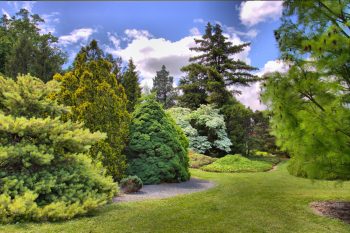The hedge. Along the north side of our property is a hedge of Euonymus japonicus (Japanese spindle, although I never really call it anything other than Euonymus). It’s pretty healthy and flourishes even in rough years. The deer seem to like it and when it’s in bloom, the entire hedge buzzes with hundreds of bees. The flowers are not at all showy, but they are quite sweet smelling and last for a few weeks. The fruit, shown here, is quite interesting, I think, and adds a small amount of color at a time of year when it’s very welcome.
Tagged With: Evergreen
Euonymus japonicus (Japanese Spindle)
Holly Flowers
We don’t normally think of hollies as being flowering tress but of course they are, as members of angiosperms (a.k.a. the magnoliophyta) they are flowering plants. Their flowers are not nearly as showy as their fruit, however, consisting of tiny, yellow flowers. Holly flowers are generally greenish white and as you can see in this picture, on this particular holly they are grouped along the stem in. They have four petals and this holly, like most species of Ilex is dioecious, meaning that there are separate male and female plants. This one is apparently male, as it has flowers each year but never has fruit.
Camellia ‘Dad’s Pink’
I currently have three camellia plants in the yard. This one it the largest and has the most flowers. It’s called ‘Dad’s Pink’ and though it isn’t a variety that my dad grew, it reminds me of him. I also have ‘Pink Perfection’, which he did have. That one ws quite small when I got it and has taken a little while to get established but it looks like it’s doing pretty well finally (and after I lowered the pH around it a bit). The third is called ‘Mrs. Lyman Clarke’ and dad had that one, as well, out back beside the chimney. It’s barely alive and only time will tell if it’s going to survive. It has six leaves and one flower bud.
Camellia x ‘Winter’s Star’
I bought this camellia, called ‘Winter’s Star’, from Camellia Forest and planted it along the fence at the north end of our back garden. It’s doing well and is coming into bloom. This is a cross between Camellia oleifera and Camellia hiemalis ‘Showa-no-sakae’ and as you can see, it has single, pink flowers and is a fall bloomer. It’s only three or so feet tall at this point, but it should get large enough to be a really striking fall feature in that part of the yard. I bought and planted two other camellias at the same time. These others are both C. japonica and are called ‘Hokkaido Red’ and ‘April Rose’, both spring bloomers.
Juniper Leaves and Berries
One of my favorite color combinations is the blue of juniper berries and the green of their leaves. I especially like it on an overcast day, when the colors are more vivid. Either color on its own is attractive and in the running for a favorite color, but the combination is especially nice.
Cathy, Dorothy, and I went for a walk on the Blue Mash Trail this afternoon and that’s where this photo was taken. As usual, it was nice to be out in the woods and meadows for a while and we always have plenty to talk about.
Gotelli Conifer Collection
I have always enjoyed the U. S. National Arboretum at New York Ave (US 50) and Bladensburg Rd (US 1) in Northeast Washington. Probably my second favorite parts, after the rose garden in bloom, is the Gotelli Conifer Collection. William Gotelli collected more than 1,500 plants from around the world for his South Orange, N.J. garden. He donated his collection to the Arboretum in 1962. I can attest to the fact that it has changed considerably over the years as the various plants have matured. I’m sure there have been losses, replacements, and additions. Nevertheless, it’s a testament to what one person can do if they have a passion. We often are too tired by the time we get to this part of the Arboretum, so I asked specifically if we could make that one of our stops this trip.






